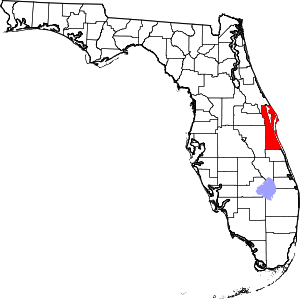Palm Shores, Florida
Palm Shores is a town in Brevard County, Florida. The population was 900 at the 2010 United States Census.[5] It is part of the Palm Bay–Melbourne–Titusville Metropolitan Statistical Area.
Palm Shores, Florida | |
|---|---|
| Town of Palm Shores | |
 Location in Brevard County and the state of Florida | |
| Coordinates: 28°11′27″N 80°39′34″W | |
| Country | |
| State | |
| County | |
| Area | |
| • Total | 0.60 sq mi (1.56 km2) |
| • Land | 0.60 sq mi (1.56 km2) |
| • Water | 0.00 sq mi (0.00 km2) |
| Elevation | 13 ft (4 m) |
| Population (2010) | |
| • Total | 900 |
| • Estimate (2019)[2] | 1,157 |
| • Density | 1,928.33/sq mi (743.96/km2) |
| Time zone | UTC-5 (Eastern (EST)) |
| • Summer (DST) | UTC-4 (EDT) |
| FIPS code | 12-54425[3] |
| GNIS feature ID | 0288411[4] |
| Website | www.TownOfPalmShores.org |
Geography
Palm Shores is located at 28°11′27″N 80°39′34″W.[6]
According to the United States Census Bureau, the town has a total area of 0.5 square miles (1.3 km2), all land.
Government
In 2007, the town had a taxable real estate base of $64.67 million.[7] It is the only municipality in the county to have its tax base rise in 2008.
Demographics
| Historical population | |||
|---|---|---|---|
| Census | Pop. | %± | |
| 1970 | 202 | — | |
| 1980 | 77 | −61.9% | |
| 1990 | 210 | 172.7% | |
| 2000 | 794 | 278.1% | |
| 2010 | 900 | 13.4% | |
| Est. 2019 | 1,157 | [2] | 28.6% |
| U.S. Decennial Census[8] | |||
At the 2000 census there were 794 people, 328 households, and 224 families in the town. The population density was 1,608.4 inhabitants per square mile (625.6/km2). There were 377 housing units at an average density of 763.7 per square mile (297.1/km2). The racial makeup of the town was 88.04% White, 4.41% African American, 0.50% Native American, 3.27% Asian, 0.50% Pacific Islander, 1.01% from other races, and 2.27% from two or more races. Hispanic or Latino of any race were 4.28%.[3]
Of the 328 households 29.0% had children under the age of 18 living with them, 59.8% were married couples living together, 6.4% had a female householder with no husband present, and 31.7% were non-families. 26.5% of households were one person and 10.1% were one person aged 65 or older. The average household size was 2.42 and the average family size was 2.96.
The age distribution was 22.0% under the age of 18, 5.4% from 18 to 24, 26.7% from 25 to 44, 29.7% from 45 to 64, and 16.1% 65 or older. The median age was 43 years. For every 100 females, there were 98.5 males. For every 100 females age 18 and over, there were 98.4 males.
The median household income was $47,500 and the median family income was $63,333. Males had a median income of $38,194 versus $26,000 for females. The per capita income for the town was $22,390. About 5.7% of families and 9.3% of the population were below the poverty line, including 12.6% of those under age 18 and 10.0% of those age 65 or over.
References
- "2019 U.S. Gazetteer Files". United States Census Bureau. Retrieved July 2, 2020.
- "Population and Housing Unit Estimates". United States Census Bureau. May 24, 2020. Retrieved May 27, 2020.
- "U.S. Census website". United States Census Bureau. Retrieved 2008-01-31.
- "US Board on Geographic Names". United States Geological Survey. 2007-10-25. Retrieved 2008-01-31.
- "Profile of General Population and Housing Characteristics: 2010 Demographic Profile Data (DP-1): Palm Shores town, Florida". United States Census Bureau. Retrieved January 31, 2012.
- "US Gazetteer files: 2010, 2000, and 1990". United States Census Bureau. 2011-02-12. Retrieved 2011-04-23.
- Dean, James (April 26, 2008). More taxes or fewer services. Florida Today.
- "Census of Population and Housing". Census.gov. Retrieved June 4, 2015.
